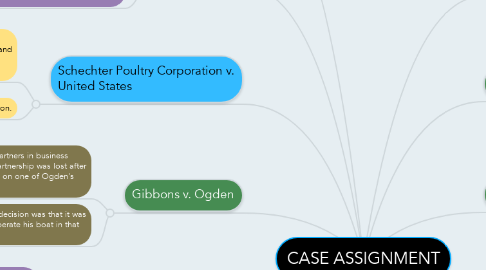
1. Debs v. United States
1.1. Debs arranged an antiwar speech in Canton, Ohio. He was arrested under the espionage act of 1917 for trying to arrange mutiny and treason by cohersing men into fighting the draft.
1.2. It was found that Debs had tried to obscure the draft and recruitment for the war. Debs argued that this was against his right to free speeck in thr First Amendment.
2. Marbury v. Maddsion
2.1. 1803, formed the basis for the exercise of judicial review in the United States under Article III of the Constitution.
2.1.1. The court's decision helped to define the boundary between the constitutionally separate executive and judicial branches of the American form of government.
2.2. The Court ruled 4-0 in the favor of Maddison.
2.2.1. The constitution was the fundamental and paramount of the nation. And also that "an act of the legislature repugnant to the constitution is void."
3. Lochner v. New York
3.1. In 1899 Lochner was charged with a violation of section 110 of Article 8, Chapter 415, of the Laws of 1897
3.2. By a vote of 5–4, The Supreme Court ruled that the law limiting bakers' working hours did not constitute a legitimate exercise of state police powers.
4. Fletcher v. Peck
4.1. First time the Supreme Court said a state law was unconstitutional. Georgia legislature approved a land grant for the Yazoo Lands. The next legislature appealed the law and voided any transactions that were made under it.
4.2. The Supreme Court came to the decision that the states legislature's repeal of the law was unconstitutional.
5. Roe v. Wade
5.1. 1973, ruled unconstitutional to a state law that banned abortions unless in the process of saving the mother.
5.1.1. The court ruled that states were not allowed to regulate abortion laws during the first trimester of the pregnancy.
5.2. The Supreme Court ruled 7-2 in the case.
5.2.1. The court argued that the first, fourth, ninth,and fourteenth Amendments protect an individuals "Zone of Privacy."
6. Dartmouth College v. Woodward
6.1. King George III gave a charter to Dartmouth Collage in 1769. What this document did was spell out the purpose of the school, set up the structure to govern it, and gave land to the college. Thirty years after the American Revolution New Hampshire tried to alter the Charter but trustees of the Collage didn't like that and sought to have the actions of the legislature declared unconstitutional.
6.2. On February 2, 1819 the ruling was in favor of the Collage and made the act of the New Hampshire Legislature invalid and the Collage kept is seal, buildings, and charter.
7. Schechter Poultry Corporation v. United States
7.1. 1935,The court ruled that invalidated regulations of the poultry industry according to the non-delegation doctrine and as an invalid use of Congress' power under the commerce clause.
7.2. 9-0 in favor of the Poultry corporation.
7.2.1. The court ruled in section 3 was "without precedent" violating the constitution.
8. Gibbons v. Ogden
8.1. Aaron Ogden and Thomas Gibbons were partners in business together in the steamboat business. The partnership was lost after three years when Gibbons operated a boat on one of Ogden's routes.
8.2. The courts decision was that it was ok for to operate his boat in that area.
9. Brown v. Board of Education
9.1. 1954, ruled unconstitutional to separate public schools for black and white kids.
9.1.1. The court's decision overruled the Plessy v. Ferguson case, which allowed state - sponsored segregation.
9.2. The Supreme court ruled 9-0 in the case. Brown winning.
9.2.1. The court argued that the thirteenth, fourteenth, and fifteenth amendments protected rights of the African American's.
10. Plessy v. Ferguson
10.1. 1896, ruled state requirements in racial segregation, in public facilities in the doctrine of "equal but separate".
10.1.1. Case was later brought up in the Brown v. Board of Education and was voted opposite than in the first case.
10.2. Ruled 7-1 in favor of the doctrine "equal but separate". Keeping segregation in all public facilities.
10.2.1. This broke the thirteenth, fourteenth, and fifteenth amendments of equal rights to African American's in the Constitution.
11. Dred Scott v. Sandford
11.1. In 1857 an African American named Dred Scott tried to sue for his freedom after his owner took him to a free state.
11.2. The court denied his request in a 7-2 decision.
12. United States v. E.C. Knight and Co.
12.1. 1892, Also known as the "Sugar Trust Case".
12.1.1. This case was to limit the government's power to control monopolies.
12.2. The Supreme Court ruled 8-1 against the government.
12.2.1. "the power to govern men and things within the limits of its dominion," is a power originally and always belonging to the states, not surrendered by them to the general government nor directly restrained by the Constitution of the United States

